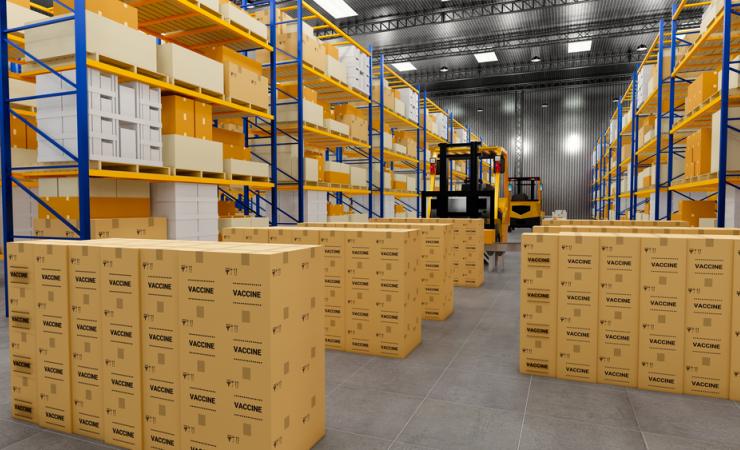Vaccines often involve biological components like proteins which are sensitive to changes in the environment around them. If proteins are exposed to excess heat or light, they change and do not work the way they should. This means that in transit, vaccines can become denatured and may not work by the time they reach their destination.
“Vaccines are often very fragile and thermo-sensitive,” says Didier Clenet, principal scientist for Sanofi, who is involved in the Inno4Vac project. “We need to take into account the last miles [that a vaccine has to travel to reach its final destination] and the end-of-shelf-life when vaccines are used in hot countries. The effect of temperature can be dramatic – for example three days at 35 degrees Celsius, the ambient temperature in hot countries, can be chaotic for vaccine stability.”
Exposure to temperature changes can happen while a vaccine is in transit from one destination to another. And it’s not just temperature that can impact vaccine stability – certain vaccines can also be affected by agitation, so the movement that happens naturally as a vaccine is transported in a truck or on a ship could be problematic. What’s more, the shelf life that a vaccine has in colder countries might not be the same as the shelf life that it would have if the ambient temperature was higher.
The Inno4Vac project is developing a model based on Bayesian statistics that predicts whether a new vaccine formulation will be stable, and which will also determine the best composition of different non-active compounds – known as excipients – that need to be added to the vaccine mix to boost stability. This model will speed up vaccine development, because vaccine manufacturers can plug the properties of the excipient into a computer model which will make an accurate estimation of how effective the excipient will be, reducing the number of lab tests that need to be run.
That means that the dud excipients can be eliminated at an early stage without going through costly scientific trials, increasing the efficiency of the vaccine development process and meaning that new vaccines will hit the market more rapidly.
“We might need to quickly develop vaccines in the future if we face another pandemic,” says Laurent Natalis, associate director of Pharmalex who is also involved in the Inno4Vac project, “but at the moment we need about three years just to be able to perform all the stability studies to assess whether a vaccine is stable enough.”
Securing the selection of best formulation of excipient
Simulations have been used for this purpose before, but the application of the Bayesian approach and the advanced kinetic models championed by Inno4Vac is a vast improvement on existing models.
Using modern mathematical approaches involving the design of experiments and Bayesian statistics means that different combinations of several excipients are tested simultaneously, much more quickly than would be possible otherwise. For instance, right now in many companies one excipient is tested, then what is learned is applied when a second excipient is tested, then a third, etc. With modern statistical approaches (such as Quality by Design and Bayesian statistics), if compatible, all those excipients can be tested at the same time and learnings can be rapidly integrated to speedily determine the optimal combination of excipients.
“The game here is to try to find what combination of excipients allows us to have a vaccine that is as stable and robust as possible,” says Natalis.
Cutting down on vaccine waste by making predictions
In the future, taking advantage of kinetic models and Bayesian statistics, these tools can also be used to make predictions – determining how long a vaccine could remain stable at suboptimal temperatures, for instance, and what the shelf-life of a vaccine is.
"The Bayesian statistics used in the models developed by the Inno4Vac project will complement existing models that are used to calculate the predictability of vaccine stability,” says Clenet.
The statistical models could also lead to reduced waste of vaccines, because they are able to predict whether a vaccine exposed to a certain temperature for a stated length of time will remain within safety and efficacy specifications, or not. This was already put to the test in Brazil, where a delay in shipping resulted in a batch of vaccines being exposed to suboptimal temperatures for a short period of time. Usually, these batches would be thrown away, but these advanced kinetic models (AKMs) proved that the vaccines had not been exposed to these temperatures for long enough to degrade and would still be potent enough to be effective.
“We were able to simulate that such short-term excursions would not have an impact on vaccine stability,” says Clenet. “Thanks to that, the authorities in Brazil accepted the simulation and released the batch. It’s key for us to develop kinetic models to secure the release of batches that are safe.”
The public-private framework of the Inno4Vac project was crucial to the success of this work on stability. Private partners provided existing data which helped to determine the parameters of a ‘good’ excipient, and both public and private partners worked together using that data to improve the model.
The results of the vaccine stability part of the Inno4Vac project are already being used by Sanofi for at least two different projects. A key question for those projects is determining the concentration range that can be used for each excipient during the production of vaccines without having any impact on stability.
Past the project’s end on a live-attenuated vaccine and a subunit adjuvanted-based vaccine, future studies could investigate whether this model can be applied universally to many different kinds of vaccines and new versions of the model could incorporate not only predictability but also probabilities using the Bayesian statistics approach.
Inno4Vac is supported by the Innovative Medicines Initiative, a partnership between the European Union and the European pharmaceutical industry.
